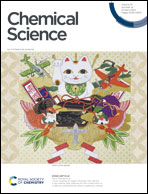Oxidation-induced ambiphilicity triggers N–N bond formation and dinitrogen release in octahedral terminal molybdenum(v) nitrido complexes†
Abstract
Coupling of octahedral, terminal d1 molybdenum(V) nitrido complexes supported by a dianionic pentadentate ligand via N–N bond formation to give μ-dinitrogen complexes was found to be thermodynamically feasible but faces significant kinetic barriers. However, upon oxidation, a kinetically favored nucleophilic/electrophilic N–N bond forming mechanism was enabled to give monocationic μ-dinitrogen dimers. Computational and experimental evidence for this “oxidation-induced ambiphilic nitrido coupling” mechanism is presented. The factors influencing release of dinitrogen from the resulting μ-dinitrogen dimers were also probed and it was found that further oxidation to a dicationic species is required to induce (very rapid) loss of dinitrogen. The mechanistic path discovered for N–N bond formation and dinitrogen release follows an ECECC sequence (E = “electrochemical step”; C = “chemical step”). Experimental evidence for the intermediacy of a highly electrophilic, cationic d0 molybdenum(VI) nitrido in the N–N bond forming mechanism via trapping with an isonitrile reagent is also discussed. Together these results are relevant to the development of molecular catalysts capable of mediating ammonia oxidation to dihydrogen and dinitrogen.

- This article is part of the themed collections: 2024 Chemical Science HOT Article Collection and 2024 ChemSci Pick of the Week Collection


 Please wait while we load your content...
Please wait while we load your content...